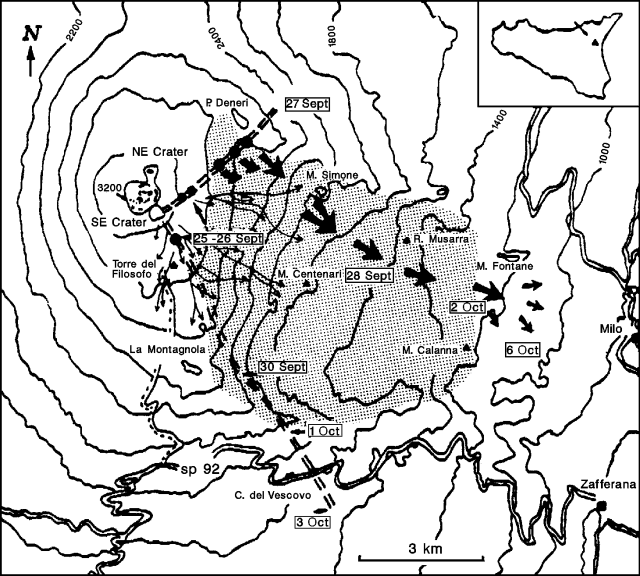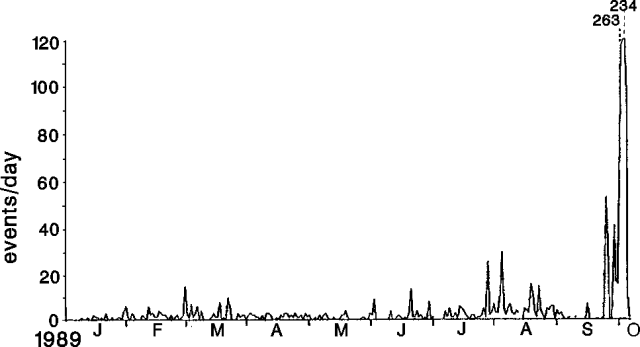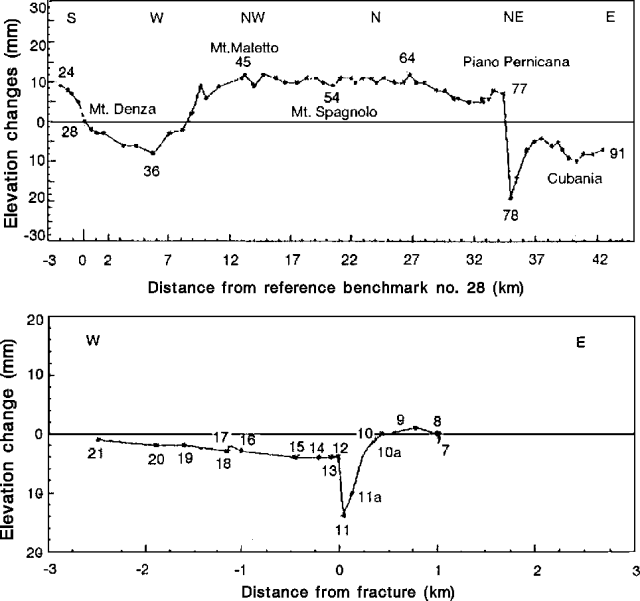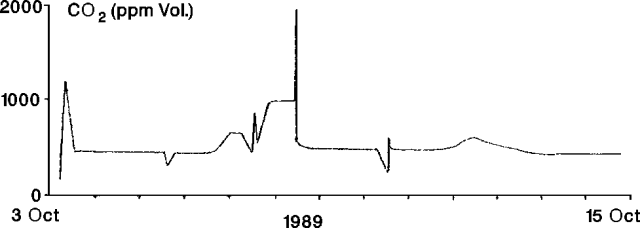Report on Etna (Italy) — October 1989
Scientific Event Alert Network Bulletin, vol. 14, no. 10 (October 1989)
Managing Editor: Lindsay McClelland.
Etna (Italy) Details of September-October eruption
Please cite this report as:
Global Volcanism Program, 1989. Report on Etna (Italy) (McClelland, L., ed.). Scientific Event Alert Network Bulletin, 14:10. Smithsonian Institution. https://doi.org/10.5479/si.GVP.SEAN198910-211060
Etna
Italy
37.748°N, 14.999°E; summit elev. 3357 m
All times are local (unless otherwise noted)
The following report (quoted sections technically edited by F. Barberi, A. Bertagnini, P. Landi, and R. Rapuzzi) summarizes studies of Etna's recent activity.
Eruption chronology. "The vigorous Strombolian activity at three summit area craters (Bocca Nuova, La Voragine, and Southeast Crater) observed during May, June, and July (14:07) declined during the first 20 days of August, then progressively resumed in the last 10 days of the month. On 29 and 31 August, after some days of Strombolian activity, La Voragine emitted a 700-m-high tephra column with fallout of lapilli and ash that affected the SE flank to the coast, 19 km from the crater.
"In the first days of September, Strombolian activity also increased at Bocca Nuova and in the morning of 10 September an explosive eruption, identical to those of 29 and 31 August, occurred again at La Voragine. Beginning in the early hours of 11 September, Strombolian activity also resumed at Southeast Crater, then progressively evolved into lava fountaining. Lava spilled over the rim of Southeast Crater, forming two fluid, fast-moving flows that traveled ~2 km SE. Explosive activity and lava spillover then suddenly ceased, indicating lowering of the magma column in the conduit. On the evening of the same day, and 12 more times until 27 September (figure 29), new episodes of vigorous Strombolian activity, evolving into lava fountaining with effusion, were observed at Southeast Crater, each suddenly ceasing and giving rise to slow degassing followed by the resumption of less vigorous Strombolian activity. Lava flows emitted during these 14 effusive episodes were confined to the upper S and SE flank area (Torre del Filosofo-Cisternazza) and descended 2.5-3 km S and SE (figure 30)."
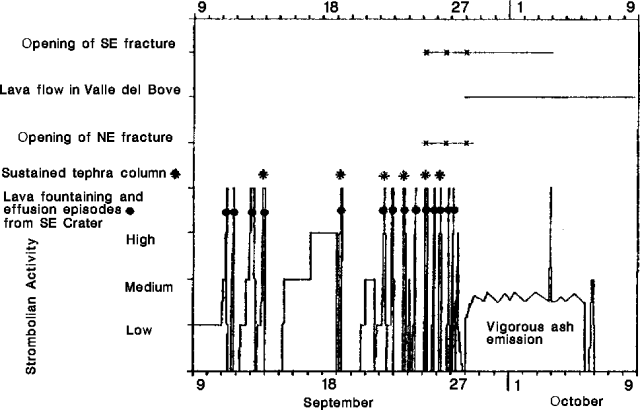 |
Figure 29. Schematic chronology of Etna's September-October 1989 eruption. Periods of eruptive activity on the NE and SE fractures are indicated by x's. |
During fieldwork on the 23rd, geologists observed that the area between Southeast Crater and the TDF was covered by fresh aa, in a flow field that had advanced around the TDF and continued southward. The most distal lobes stopped moving on 22 September.
"Near the end of the lava fountaining phase, in at least six cases (13, 19, 22, 23, 25, and 26 September) a sustained tephra column was formed, with consequent lapilli and ash fallout over the E and SE flank to the coast. On [24] September, two fracture systems, trending [N40°E] and N140°E, opened on the flanks of the newly formed Southeast Crater cone, down to elevations of 2,800 and 2,900 m respectively. An appreciable quantity of lava spilled either over the Southeast Crater rim or from the two newly formed fractures on 25 September and in the following two days. In the morning of 25 September a lava flow from the NE fracture descended 3 km in the Valle del Bove, to 1,900 m (M. Simone area, figure 30). The last episode of lava fountaining and effusion at Southeast Crater occurred the morning of 27 September. Since that afternoon the crater has been characterized by Strombolian activity and ash emission."
On the evening of 27 September, the focus of activity shifted to the NE fracture system. "At about 2200 a small fast-moving flow was emitted from the terminus of the NE fracture, and descended 2 km in the Valle del Bove. The Strombolian activity of Southeast Crater then [temporarily] ceased, and between 2300 and 2330 a series of eruptive vents opened at 2,550 m elevation in the Valle del Leone (upper part of the Valle del Bove), preceded and accompanied by a vigorous seismic swarm. These vents were aligned along a N50°E fracture, on the extension of the fracture cutting the NE flank of the SE cone (figure 30). Lava poured from 3-4 vents, where degassing was minor with ejection of lava fragments to only a few meters height. The various lava tongues converged a short distance from the fracture into a main channel, 10 m wide, where lava advanced rapidly. At dawn on 28 September the flow had descended 5 km in the Valle del Bove, reaching Rocca Musarra at ~ 1,650 m elevation.
"That morning, the SSE fracture (extending N140°E from Southeast Crater) was also seen to have progressed downslope. This newly formed part of the fracture system affected a 100-m-wide sector, extending down 2.5 km (to Cisternazza) and to the upper (W) part of the Valle del Bove. Fracture propagation continued on 29 and 30 September, when the S scarp of the Valle del Bove was affected. On 1 October the fracture, accompanied by marked collapses along the fissure system, crossed the Valle del Bove scarp and propagated farther downslope, following the feeding fissure of the 1792 flank eruption. At 1200 on 2 October the fracture cut route SP92 connecting Zafferana to Rifugio Sapienza. The seismic activity that accompanied the entire fracturing process peaked at that time, with ~40 shocks/hour (figure 31). In the following hours, seismic activity rapidly declined and fracture propagation stopped at ~ 1,500 m elevation, 8 km from Southeast Crater. In the following three days only widening of single fissures was observed, with development of consistent compressive structures (uplift folding, reverse faulting) on both sides of the main extensional (open) fissure."
During fieldwork the night of 1 October (by C. Oppenheimer, M. Pompilio, M. Coltelli, and V. Scribano) the flow near the NE fracture's main vent was ~ 8 m wide, and its center was moving at faster than a walking pace. Blocks of lava tossed onto the flow welded instantly but did not sink. A maximum lava surface brightness temperature of 1,039°C was measured by a 0.8-1.1 mm bandpass infrared thermometer (recording for 10 minutes, 3 m from the flow top).
Guy Kieffer notes that the axes of the two fracture systems that opened during the eruption had both been frequently active during the eruptive cycle that began in 1971: the NE axis in 1971, 1978, 1979, and 1986-87; and the SSE axis in 1971, 1978, 1979, 1983, and 1985 (along a southward extension). The NE axis had also been active during the 1811, 1865, and 1928 eruptions, and the SSE axis in 1792, 1908, and 1910. As in the present eruption, fissures had opened from the SSE base of the central cone in 1874, 1911, and 1923 without producing any lava, while lava was emitted from N flank fissures. The 1989 eruption's SSE fracture had opened ~ 45 cm and had a right-lateral displacement of ~ 15 cm (on 7 October) where it crossed route SP92. Kieffer suggested that the SSE fracture was the result of an offset caused by intrusion below Southeast Crater, added to several years of accrued stresses as part of the E flank is forced eastward.
"Lava outpouring from the Valle del Leone fissure continued until 2 October without significant variation in the effusion rate. From 3 October, oscillations, but with a slow progressive decrease, were observed in the rate of lava effusion. During temporary phases of effusion rate increase, eruptive vents were reactivated at higher elevation on the NE effusive fracture. New hornitos were formed, 50 m above those at the 1,550-m vents, accompanied by a series of lava overflows. The effusion rate decreased further on 6 October and lava emission stopped during the night of 8-9 October.
"During the same period, explosive activity continued at Southeast Crater. After the late morning of 28 September ash-laden clouds were emitted from the crater, which also showed Strombolian activity of variable intensity." When observed by C. Oppenheimer on 29 September, discrete eruptions of ash and blocks about every 30 seconds were superimposed on continuous ash emission. Ballistic trajectories of incandescent bombs that rose >400 m above the crater were visible at night.
"Tephra were dispersed eastward by the wind, causing ash showers on Catania and eastern villages, especially on 3 and 4 October. Limited episodes of lava fountaining last occurred during the night of 3-4 October. Strombolian activity stopped during the night of 6 October, whereas discontinuous weak ash emission continued until 9 October. Southeast Crater appeared almost totally obstructed on 11 October. Ash emission and vigorous degassing continued, since 9 October, only at Bocca Nuova.
Lava flows. "Etna's 27 September-9 October flank eruption produced an aa flow field in the Valle del Leone-Valle del Bove ~ 6.5 km long and 5-10 m thick, with a volume of 10-20 x 106 m3. The flows descended from ~2,550 to 1,100 m elevation. The average effusion rate is estimated at 10-20 m3/second, with peak daily average values during the first 4 days of eruption (until 2 October) of between 15 and 25 m3/second. Combinations of the overall emplacement characteristics (e.g. length-average effusion rate, length-volume, width/length-duration) of the flow fields lie within ranges typical for Etna's historic lavas. Velocity and dimension measurements of active overflows at the feeding vent (Valle del Leone, ~ 2,550 m asl) on 2 and 4 October suggest apparent viscosities for the initial lava of the order of 10,000 Pas, for bulk shear rates between 0.01 and 0.1/s. Thermocouple data yielded a surface temperature of 800°C on the overflow (after it had advanced ~ 50-75 m) on 2 October. Preliminary analysis of infrared data obtained on the ground on 5 October suggests a similar temperature for incandescent cracks in an active flow front ~ 6 km from the vent.
Petrology. "The lavas are porphyritic (P.I. = 30-40) alkali basalts with phenocrysts of plagioclase, clinopyroxene, and olivine, and microphenocrysts of Ti-magnetite. There are only minor differences, in size and relative abundance of phenocrysts, between the Southeast Crater flows and the Valle del Leone lavas. Two representative chemical analyses are shown in table 4. The 1989 lavas are slightly more mafic and magnesian than those of either the last Etna eruptions (1986-87 average) or Southeast Crater in 1988.
Table 4. Chemistry of 1989 lavas from Etna's Southeast Crater (11 September) and the Valle del Leone 93 October). Analyses by X-ray Flourescence at the Dipt. di Scienze della Terra, Univ. di Pisa, except Na2O and MgO (Atomic Absorption Spectrophotometer) and FeO (titration) at IIV.
| Oxide | Southeast Crater | Valle del Leone |
| SiO2 | 47.46 | 46.70 |
| TiO2 | 1.78 | 1.78 |
| Al2O3 | 18.11 | 17.36 |
| Fe2O3 | 2.83 | 4.30 |
| FeO | 7.32 | 7.41 |
| MnO | 0.19 | 0.20 |
| MgO | 5.57 | 5.84 |
| CaO | 10.39 | 10.25 |
| Na2O | 3.45 | 3.51 |
| K2O | 1.99 | 1.81 |
| P2O5 | 0.44 | 0.41 |
| LOI | 0.48 | 0.44 |
Civil Protection aspects. "The lava flow emitted from the SE fractures in the Valle del Leone did not present any serious civil protection problem. Flow fronts advanced very slowly at elevations lower than 1,200 m. The flow was confined within the totally uninhabited Valle del Bove and never threatened villages or lifelines. However, the propagation of the SE fracture system from Southeast Crater downslope caused serious concern. Because of strong seismic activity and marked uplift on that sector of the volcano, route SP92 was closed to traffic 24 hours before it was cut by the fracture. The terminus of the fracture was located in a zone that had been affected by flank eruptions in the past (e.g. in 1792). It was at low elevation (~ 1,500 m) and only 5-6 km from villages (Malpasso, Fleri), a distance that could be traveled by a fluid lava flow in a dangerously short time, considering that magma was at the surface in Southeast Crater vent (3,000 m elevation) and hence there was a very high potential load (1,500 m of lava column) on the fracture apex.
"The more probable paths of lava flow in case of effusion from a vent at 1,500 m elevation were estimated on a morphological basis. People living on the potential lava trajectories were alerted to the potential risk and a plan was established for their prompt evacuation.
"Scientific monitoring at the fracture terminus was expanded and reinforced with a mobile seismic network, precision levelling, microgravimetry, geodimeter lines, and soil gas geochemistry. I gas;sampling Visual observation points (24 hours/day) were established near the fracture apex and along the expected flow path, radio linked with the army units responsible for the emergency plans.
"The alert system was maintained until 16 October. Then, with six days having passed since the end of eruptive activity and without any sign of potential volcanic activation of the SE fracture, the eruption was considered concluded.
Seismicity. "Seismic activity has been monitored since early summer 1989, using both the IIV's permanent array (8 stations) and a temporary array operated by the OV (up to 11 three-component telemetered digital stations). The daily frequency histogram is shown in figure 31.
Pre-eruptive period."Five major seismic sequences were recorded from late July to late August; none of the events exceeded M 3.3. Focal depths, calculated with respect to the highest stations (at 2,900 m asl) ranged from ~ 15 km (3 August, 45 events) to
Eruptive period. "On 23-24 September, a swarm of 84 events (M >3.2) was located at ~20 km depth. Three days later, during a period of large fluctuations in tremor amplitude, intense microseismic activity preceded and accompanied the opening of the eruptive fissures on the E flank. Because of its weakness (only 19 events of M>2), this activity was clearly observed only at the nearest station (PDN, ~ 1 km from the new vents).
"More than 1,000 shallow events (depth
Volcanic tremor. "Volcanic tremor was monitored at stations PDN (hourly analysis) and SLN (real-time analysis). A rapid increase in tremor energy was recorded during the morning of 10 September. The level of tremor remained high for four days, with an estimated daily energy release of 1017 ergs (1010 J), then dropped by about an order of magnitude (figure 32). Between 18 September and 6 October, near-periodic (daily/half-daily) oscillations could be distinguished in the tremor amplitude (minor peaks in energy release on 19, 22, 25, and 27 September, and 4 October). With the end of the eruption on 9 October, tremor amplitude dropped to the pre-crisis level. Energy spectra analysis of 5-minute samples from station SLN shows steady peaks in the 1.4-1.9 Hz band, independent of energy level, while spectral displacements to higher frequencies were occasionally observed at station PDN.
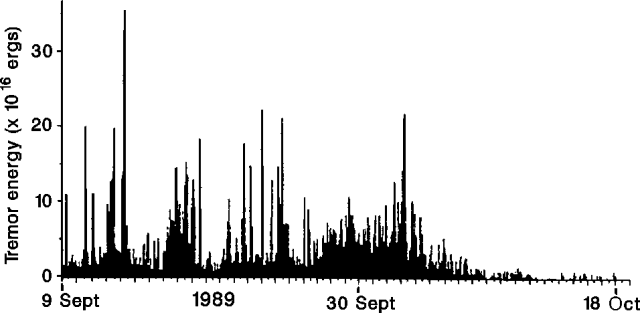 |
Figure 32. Daily release of tremor energy recorded by SLN (Serra la Nave) station, 9 September-18 October, 1989. |
Ground deformation - tilt. "Tilt data have been collected at an IIV borehole biaxial tilt station (SPC), located along the SE flank at ~ 1,600 m elevation. Continuously monitored tilt signals indicated a positive variation of the radial component (crater up), clearly exceeding the signal confidence limit, since the beginning of June 1989. The tangential component of the tilt remained practically flat until the beginning of the fracturing phase affecting the SE flank by 2 October. Both radial and tangential tilt underwent a sharp variation by the afternoon of 1 October, suggesting a rapid inflation of the Valle del Bove's S outer flank, where the fracture later propagated. The almost constant ratio between the two tilt components throughout this phase of the deformation process depicts a resultant tilt vector trending approximately N25°E (up) and totaling 14 µrad by the end of the deformation phase.
"Additional tilt data were obtained by two stations (sensor made of a pair of horizontal pendulums) installed by IIV and IPGP. The two automated stations (GIA and TRE) recorded an uplift of the summit area since the first 10 days of June (radial component, figure 33). Marked variations were recorded during the SE fracture propagation, particularly at TRE station, only 200 m from the fracture.
 |
Figure 33. Radial (top) and tangential (bottom) data from the GIA horizontal pendulum tilt station, 21 May-13 October, 1989. |
Ground deformation - geodimeter. "A trilateration network on the SE flank area had been previously surveyed in 1987, 1988, and May 1989. Daily EDM measurements were made on some of the network benchmarks since 30 September, before the fracture propagated downslope. Horizontal strain solutions for the main deformation phase that occurred on 2 October indicated an overall areal contraction (~152 ppm) with a minimum extension axis of about -206 ± 80 ppm striking N30°E; maximum shear was 260 ppm. Distance measurements across the main fracture system, at ~ 1,700 m elevation, indicated a local extension of up to ~ 1 m between May 1987 and October 1989.
Ground deformation - levelling. "Precise levelling surveys around the circumference of the volcano and across the new fracture system where it cuts route SP92 were carried out 2-16 October. With respect to September 1988, the N part of the volcano had remained stable, while relative sinking had occurred at the station closest to the central crater (20 mm) and across the fault at Piano Pernicana (25 mm; figure 34). Along route SP92, repeated surveys 6-16 October indicated a relative sinking near the new fracture system of ~ 14 mm.
Microgravimetry. "On 3 October the pre-existing microgravimetric network (OV, IIV) was expanded near the fracture cutting route SP92. A new 2-km-long E-W line was established, with eight stations symmetrically arranged across the fracture, each coinciding with a precision levelling benchmark. Gravity measurements were carried out on 3, 4, 6, and 11 October. Differences from 3 to 4 October (figure 35) show a positive variation of the gravity field with a maximum (18 ± 7 microgal) corresponding to the fracture. Subsequent gravity variations remained mostly within the error range. Correction for levelling data does not appreciably modify these results.
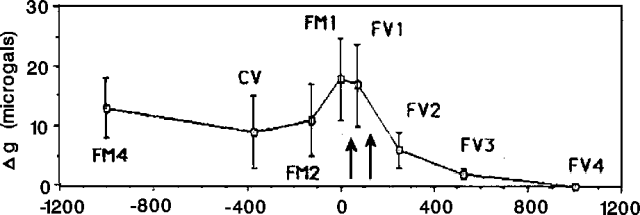 |
Figure 35. Gravity changes across the SE fracture (indicated by arrows) along route SP92, 3-4 October, 1989. |
Geochemistry - COSPEC data. "A slow increase in SO2 output from the summit craters was observed in August 1989, with a transition from very low values (1,000 t/d) to medium-high values (~ 7,000 t/d). In the first half of September, SO2 flux remained around medium values. Since 14 September, coinciding with the Valle del Leone effusive phase, SO2 emission increased markedly with oscillation around 15,000 t/d, three times the average Etna values. [Measured rates of SO2 emission exceeded 25,000 t/d on one day around 18 September and reached ~ 23,000 t/d on another day near 1 October].
Geochemistry - soil gases. "From 3 to 14 October, CO2 was measured in the soil close to the terminus of the SE fracture. CO2 concentrations were determined at a soil depth of 50 cm by an IR spectrophotometer, and varied from 0 to 1,500 ppmv, with a clear anomalous degassing at the fracture which showed a progressive decrease with time (figure 36). In addition, CO2 concentration in the soil was measured continuously at one of the points. Two sharp peaks were recorded on 3 and 8 October, while later CO2 concentrations remained quite constant (figure 37).
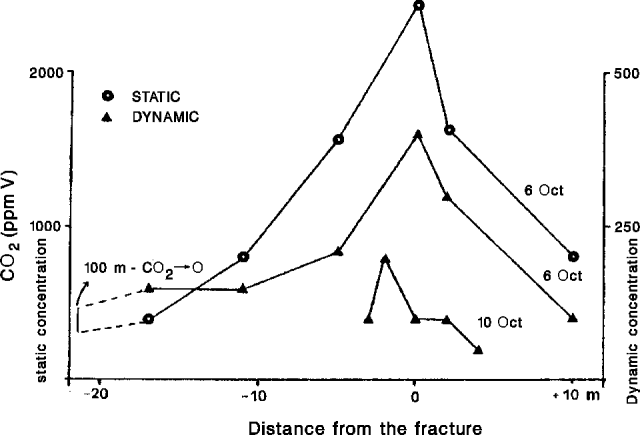 |
Figure 36. CO2 concentration in soil across the SE fracture, at 1,600 m elevation (route SP92) 6-10 October, 1989. Dynamic gas samples are taken after pumping; static samples without pumping. |
"From 9 to 13 October another soil-gas survey was carried out across the fracture. Data from 140-cm soil depths did not show any anomalous H2 and CO degassing but the data from 60-cm depths were significantly higher than atmospheric: they ranged from 3 to 12 ppmv for H2 and 0.3-58.8 ppmv for CO. The meaning of this difference of gas concentration between 140- and 60-cm-deep holes must be further investigated."
Further References. Barberi, F., Bertagnini, F., and Landi, P., eds., 1990, Mt. Etna: the 1989 eruption: CNR–Gruppo Nazionale per la Vulcanologia; Giardini, Pisa, 75 pp. (11 papers).
Briole, P., Nunnari, G., Puglisi, G., and Murray, J., L'Eruption de Septembre-Octoberobre 1989 à l'Etna (Italie): quelques informations quantitatives fournies par la géodesie et l'inclinométrie: Comptes Rendus de l'Académie des Sciences, v. 310, série II, no. 13, p. 1747-1754.
Geological Summary. Mount Etna, towering above Catania on the island of Sicily, has one of the world's longest documented records of volcanism, dating back to 1500 BCE. Historical lava flows of basaltic composition cover much of the surface of this massive volcano, whose edifice is the highest and most voluminous in Italy. The Mongibello stratovolcano, truncated by several small calderas, was constructed during the late Pleistocene and Holocene over an older shield volcano. The most prominent morphological feature of Etna is the Valle del Bove, a 5 x 10 km caldera open to the east. Two styles of eruptive activity typically occur, sometimes simultaneously. Persistent explosive eruptions, sometimes with minor lava emissions, take place from one or more summit craters. Flank vents, typically with higher effusion rates, are less frequently active and originate from fissures that open progressively downward from near the summit (usually accompanied by Strombolian eruptions at the upper end). Cinder cones are commonly constructed over the vents of lower-flank lava flows. Lava flows extend to the foot of the volcano on all sides and have reached the sea over a broad area on the SE flank.
Information Contacts: Many scientists and technicians were involved in the September-October Etna eruption, coordinated by the National Volcanic Group.
Scientific coordination and Civil Protection problems:F. Barberi, Univ di Pisa; G. Frazzetta and R. Santacroce, IIV; F. Innocenti, Univ di Pisa; G. Luongo, OV; R. Mazzuoli, Univ di Cosenza; L. Villari, Univ di Messina.
Volcanological Observations:R. Azzaro, S. Calvari, M. Coltelli, G. Frazzetta, G. Lanzafame, M. Pompilio, and R. Romano, IIV; V. Scribano, Univ di Catania; F. Barberi, A. Bertagnini, F. Innocenti, and P. Landi, Univ di Pisa; C. Kilburn, OV; L. Glaze, JPL.
Petrology:P. Armienti and F. Innocenti, Univ di Pisa; S. Calvari, M. Carà, M. Coltelli, and M. Pompilio, IIV.
Seismicity (24-hour monitoring):E. Privitera, R. Allotta, C. Cardaci, O. Cocina, D. Condarelli, V. Longo, A. Montalto, D. Patanè, A. Pellegrino, S. Rapisarda, S. Spampinato, and O. Torrisi, IIV.
Seismicity (OV mobile network and tremor):F. Ferrucci, G.P. Ricciardi, M. Calì, M. Capello, M. Castellano, U. Coppa, R. D'Alessandro, J. Dorel, D. Ereditato, V. D'Errico, G. Gaudiosi, C. Godano, and G. Milano, OV.
Seismicity – Univ di Catania:S. Gresta, G. Lombardo, and G. Patanè, Univ di Catania.
Ground deformation (IIV tiltmetry and geodimetry):L. Villari, Univ di Messina; A. Bonaccorso, O. Campisi, O. Consoli, B. Puglisi, G. Puglisi, and R. Velardita, IIV.
IIV-IPGP tiltmetry:P. Briole, G. Nunnari, G. Puglisi.
OV levelling:F. Obrizzo, H.A. Ali Naghi, C. Del Gaudio, C. Ricco, V. Sepe, OV.
Microgravimetry:G. Budetta, IIV; M. Grimaldi, OV.
Geochemistry (COSPEC):T. Caltabiano and R. Romano, IIV.
CO2:M. Valenza, G. Capasso, M. Carapezza, W. D'Alessandro, S. Giammanco, S. Gurrieri, J. Hauser, and F. Parello, IGF, Palermo.
H2 and CO:R. Cioni, G. Chiodini, A. Pescia, B. Raco, and G. Taddeucci, IGGI, Pisa, and Univ di Perugia.
Others:G. Kieffer, Univ Blaise-Pascal; C. Oppenheimer and D. Rothery, Open Univ.


